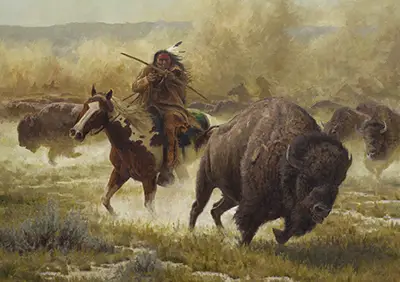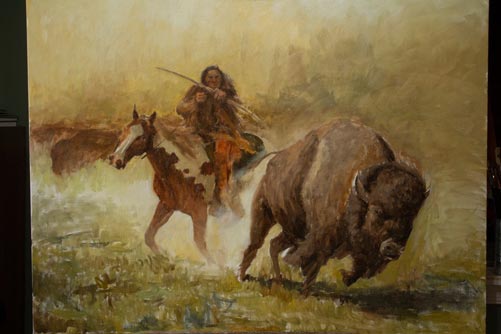
Planning a Complex Oil Painting
There are a number of steps that go into planning a complex oil painting. Below I describe the process I went through to arrive at my latest painting, Splitting the Herd, oil on linen, 36x48 inches.
Preliminary Work





When planning a complex oil painting, or any type of painting, it's always good to see if your idea will work by doing a small study. These studies do not have to be detailed or precise; their purpose is to help you visualize and plan the large shapes in the composition, the primary color scheme, and the value relationships. Detail is not a consideration at this point. See my rough preliminary study below.








Starting the Large Painting
It's now time to start the large painting. A large sheet of Claessens #15 oil-primed linen is stretched onto heavy duty stretcher bars.
A very easy and cost-effective way to enlarge a drawing for a painting is to scan your sketch into Adobe Photoshop, enlarge it to the size of the final painting, upload it onto Staples Print and Marketing Services and have it printed as a blueprint, (and no, the outlines will not be blue unless you draw them that color). Depending on your location, you can get a 36x48 inch outline printed for less than $10 if you choose the store pick-up option.
Attach the print onto your canvas by taping down just one side, then slide some carbon transfer paper underneath or apply charcoal on the backside of the print, the side that will be in contact with the canvas. You don't need to cover the entire back with charcoal, just where the lines are. Now with the print on the canvas, trace the outline of the print onto the canvas.




The block-in is started with a very limited palette. This helps me to focus on correct shapes, values, and composition. Once this foundation is laid, I have something solid to build upon.




































































Planning a Complex Oil Painting-The Final Stages
We are now beyond the initial stages of planning a complex oil painting. I left the painting alone for a day and when I returned two days later, the block-in which almost dry. This allowed me to put more paint on top for adjustments, details, and texture. The only medium that was used a odorless mineral spirits. Now I will use my full palette of Titanium White, Cadmium Lemon, Cadmium Yellow Light, Yellow Ochre, Transparent Oxide Red, Cadmium Red, Alizarin Permanent, Ultramarine Blue, Cobalt Blue, Thalo Turquoise, Viridian, and Permanent Green. Note that I'm no longer using Van Dyke Brown.




























































I hope you found this post on planning a complex oil painting helpful. Click here to see a small oil painting demo. Please leave your comments or questions below and don't forget to subscribe. Also, visit my website at www.JasonTako.com and see video demonstrations on my YouTube channel.
Disclosure: Some of the links in this post are affiliate links in which I will earn a commission, but there is no increased cost to the buyer. I link companies and their products because I use them and believe in them, regardless of whether I get a commission or not.
Jason Tako is a nationally known fine artist who specializes in western, wildlife, plein air, and Historical Native American subject matter. He spent his learning years sketching the wetlands and wooded areas of rural Minnesota. He has been featured in Plein Air Magazine and Western Art Collector Magazine and he was the Featured Artist for the 2020 Southeastern Wildlife Expo. See his work at www.JasonTako.com and his demonstrations on his YouTube Channel.
Warning: Undefined array key "preview" in /home3/mysketc2/public_html/wp-content/plugins/oxygen/component-framework/components/classes/comment-form.class.php on line 75


Warning: Undefined array key "preview" in /home3/mysketc2/public_html/wp-content/plugins/oxygen/component-framework/components/classes/comment-form.class.php on line 79